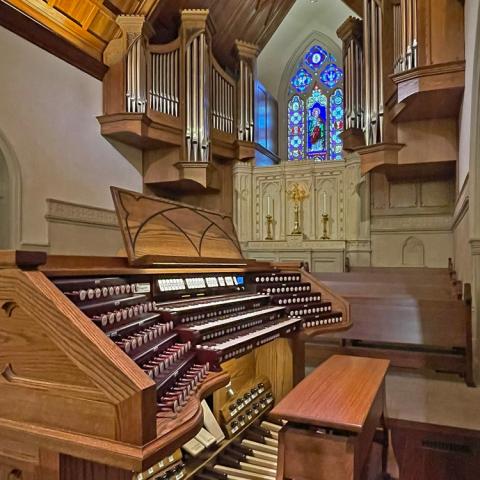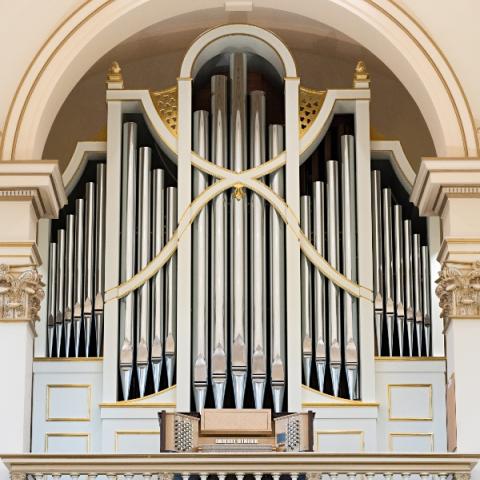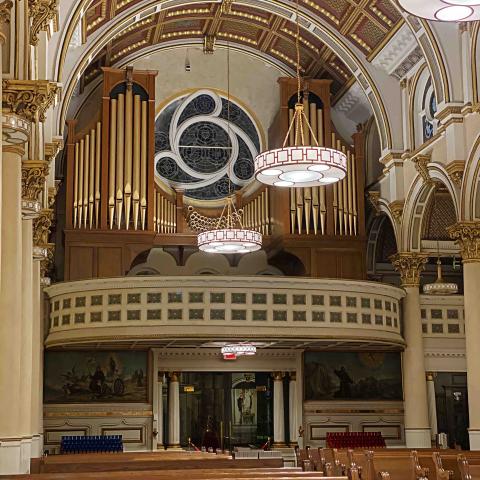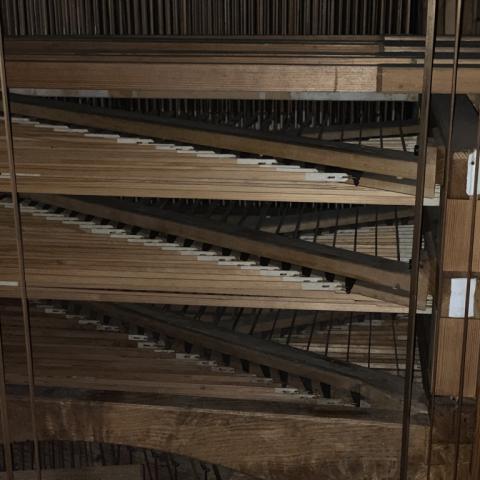Peragallo Pipe Organ Company, Paterson, New Jersey

Designing the ultimate keydesk
As an organ builder, one of the truly enjoyable tasks has always been creating an inspired console for each instrument. The console, also referred to as the keydesk, is the one piece of equipment where the organist physically interacts with the instrument to create music. Therefore, every aspect of design of the organ cockpit must be considered, and the most robust components, secure technology, and thorough finishing must be employed to assure the organist the ability to create great music. This article will examine many considerations in this design process should one have the pleasure of creating one’s own masterpiece.
The console in the cover photo is the result of a collaboration with the recently deceased organist, organ salesman, colleague, and talented organ designer Rick Tripodi for the Green’s Farms Church in Westport, Connecticut. Rick nicknamed John Peragallo IV’s design “the clocktower,” with its overt crown molding caps to each divisional tower. It’s a huge stoplist—so a thoughtful approach was required. Three years of consideration yielded some thirty-six revisions of the stop and piston layout before the final rendition. This work of art includes unusual features such as a lift that raises the console out of its pit in theatrical fashion, integrated HDMI screen to monitor the house broadcast, a control for the bell tower, and a handy pencil drawer with a phone charger.
Console design has long been a subject of discussion among organists, choral directors, architects, liturgical designers, the clergy, and sometimes even the donors. The Peragallos, having been in business for 104 years, have seen it all. Rarely is there an installation with no outside input. The ultimate decisions are left to the builder.
Crafts and trades employed include woodworking, furniture finishing, electrical engineering, musical considerations, and safety. The American Guild of Organists has also weighed in by contributing guidelines as to the correct position of the keyboards in relation to the pedalboard and the proper position of the expression shoes. The console becomes a homogenous design based on the input of specialists in each of these areas.
As to console style—there is the basic stop tablet design, rocker tablet variation, traditional drawknob with or without drop sill, English drawknob, and low-profile terraced with either straight tiers or French curved terraces, with drawknobs of either solid wood or inserts. Oblique knobs on 90-degree terraces are another possibility. A new generation of technology has now brought us backlit drawknobs and rocker tablets. And the latest-and-greatest is now a touch screen for stop control as employed in the sampled online home organs.
Each of these styles generates a myriad of decisions. For instance, whether the knobs on a terraced keydesk should be arranged with the low pitches on the outside or toward the inside, adjacent to the keyboards—arguments can be made for each approach. From a playing perspective, one tends to add the higher pitches as the music proceeds—so why not have them closer to the center? With today’s sophisticated combination systems and piston sequencing, does one even reach anymore? It may be more advantageous to have the low-pitched stops closer, since one is registering these foundations initially and then adding the higher pitches, reeds, and mixtures with divisional pistons. This can get intense, and we are only discussing knob locations.
Then there is the consideration of the divisional locations, manual locations, and couplers. We have seen everything from couplers on the nameboard to couplers in the divisions and even sub and super couplers on lit pistons on the key ends.
Manual transfers make the discussion of permanent French versus traditional keyboard locations a moot point. Some of the greatest players opt to perform French repertoire with the Grand Orgue clavier at the second key deck, rather than in the French style.
Let’s look into what goes into the design process
The primary decision is the design style of the keydesk. Each builder has their own preference. The Peragallo signature console is the low-profile terraced keydesk. Our impetus was Vatican II, with the musicians in many Catholic music ministries serving the dual role of choral director and organist. The music ministry was taken from the choir loft and positioned on the nave floor adjacent to the sanctuary in many Catholic parishes. The low-profile terraced keydesk allows clear sight lines to the choir, cantor, and celebrant—as well as the door to keep track of the bride’s progress down the aisle!
Over the years we have built many styles of consoles, as shown in the accompanying photos. These include drawknob, curved terraced drawknob, movable tilt tabs, or backlit rocker tablets on the side jambs. Care must be taken to ensure that all knobs are within reach. The combination system becomes an important element in addressing those knobs on the far extremities of the stopjambs.
Every effort is made to arrange the divisions as functionally as possible. A two-manual-and-pedal console will have the Swell drawknobs on the top two rows on the left and the Great drawknobs on the top two rows on the right. The Pedal division is split on the lower row of each side. Care is taken to ensure a logical break—preferably with the flues to the left and the reeds to the right.
A three-manual design makes things a bit simpler with four rows of knobs on each side. The Swell lives on top and the Pedal division below on the left terraces. The Great and the Choir or Positif are on the right terraces. If the lower keyboard is the Great or Grand Orgue, the Great knobs are correspondingly on the bottom two rows.
Inter-manual couplers are located on the nameboard along with the Pedal couplers. The intra-divisional subs, super couplers, and unisons can be either in their respective divisions or on the nameboard. We have also used lit pistons on the key ends very effectively for these couplers
The choice of key covering overlays is an important aesthetic decision. Typical species of wood that are acceptably hard enough include pau ferro, rosewood, cocobolo, maple, and ebony. Today’s faux ivory (crème satin) is a wonderful option for those preferring the feel of traditional ivory in lieu of bone. The selected overlay species may be incorporated into the pedal clavier to coordinate finishes.
The key tension is adjustable with preferences ranging from fall-away under-your-fingers theatre organ touch to lots of tension for those who prefer an old-school, mechanical action feel. Finally, tracker key touch comes in two forms, a toggle spring under the front of the key or a magnet tracker touch. This places more tension on the top of the key, decreasing as the key is depressed. Either approach insures the organist a clean, crisp response for secure playing.
Prior to a discussion of piston position, let’s explore the importance of locating the power switch. How many times have you spent twenty minutes playing hide and seek with the on and off? We’ve come a long way from a 220-volt motor switch hidden under the key bed or on the balcony rail.
Today’s console control systems feature digital technology. This creates a beautiful juxtaposition of high-tech control and old-world wind-blown pipes—all in the same instrument. The control system continuously scans the keys, stops, and expression shoe position, converting that information to digital format. This information is transferred into the chamber over CAT 5 or 6 cable—just a few strands of wire. What a difference from the thousands of wires of the earlier electro-pneumatic instruments. Once it reaches the pipe chamber, the digital information fires the drivers for the proper pipe valves, expression, and other controls.
Since this information is in digital format, a number of useful functions can be incorporated such as transposers, playback and record, piston sequencing, bass and melody couplers, and next and previous pistons. However, all these functions are only effective if the organist has an unimpeded view of a properly located control screen. Another useful digital feature is a USB port, which allows the organist to “take home” their work each day.
Positioning of the thumb and toe pistons is a whole art unto itself. A sufficient number of general and divisional pistons are essential, although I have witnessed extremes in usage—from the revered organist Donald Dumler of Saint Patrick’s Cathedral accompanying everything from liturgy to major choral works with just several generals and a few divisional settings, to major concert artists utilizing multiple memory levels for each selection.
There seems to be some debate as to whether generals 1–6 should be above or below generals 7–12. Page turning pistons (generals 13 and 14) are handy when placed on the right upper keyslip.
One thing that has never changed is the importance of positioning the Great to Pedal reversible under the thumb of the right hand and the Great to Pedal toe piston in an accessible position just to the right of the crescendo shoe. The Great to Pedal reversible is often the most frequented piston by every organist other than the cancel button.
Now let’s examine the cymbelstern reversible. Our preference is for a toe paddle positioned above the generals to the left of the expression shoes. As the cymbelstern embellishes the trio sonata or chorale prelude, the right foot executes the cantus firmus and with both hands occupied, the left foot finally cancels the bells. This may happen just prior to the conclusion of the work depending on how long it takes your cymbelstern to come to rest.
New to the discussion are four critical controls associated with piston sequencing and iPad page turning—the next, previous, page forward, and page back pistons. These functions must be located just under one’s fingers and easily accessible on the knee panel to allow the organist no-look access.
My brother Frank, an esteemed cabinetmaker, has designed and built casework for keydesks for most of his life and shares some of that experience and expertise:
Console shells were mass produced during the heyday of organbuilding in the 1940s through the 1960s. A trained eye would be able to discern an Aeolian-Skinner from an Austin of this period or an M. P. Möller from a Casavant. Nowadays, most console shells are a one-at-a-time custom creation. Design details are gleaned from the architectural style of the sanctuary furnishings and wood tones.
Exterior wood species selections include white oak, red oak, quartered oak, mahogany, cherry, and walnut. Contrasting interior selections include mahogany, cherry, birch, black ebony, or maple. The finished design of each console is a balance of these species that can comfortably coexist between exterior frame, interior jambs, key ends and piston slips, nameboard, and key coverings.
Exterior frame panel styles can vary from Roman arched, Gothic arched, ogee, raised solid, or Shaker recessed. Music racks have moved beyond the traditional lattice or glass into custom designs that infuse symbols relevant to the specific installation. We incorporated the Xaverian Cross in the music rack for our instrument at Saint Francis Xavier Catholic Church in New York City. Overhead LED lighting, which must clear the pages of a French organ score, has become quite popular.
Having the mobility to adjust the console location for changing musical and liturgical celebration is a priority for many churches. Keydesks are now movable via recessed casters or a movable platform. Each of these has its advantages, and today the connecting cables are so infinitesimal (or nonexistent) that multiple floor ports are a common request.
So, the next time you sit down at your organ console, remember that a whole lot of thought and consideration went into this creation. Treat it with kindness and respect. No coffee cups, please! And feel free to keep it nice and shiny.
If you are looking to upgrade your console or start fresh, we hope this helped you to aspire to and someday realize the creation of your own dream console. We hope you enjoyed our console tour and may have taken home some appreciation of the working knowledge of the organ designer.
John Peragallo III
Frank Peragallo
John Peragallo IV
Anthony Peragallo
Builder’s website: www.peragallo.com
Cover photo: Green’s Farms Church, Westport, Connecticut, shows unique “clock tower” design.







